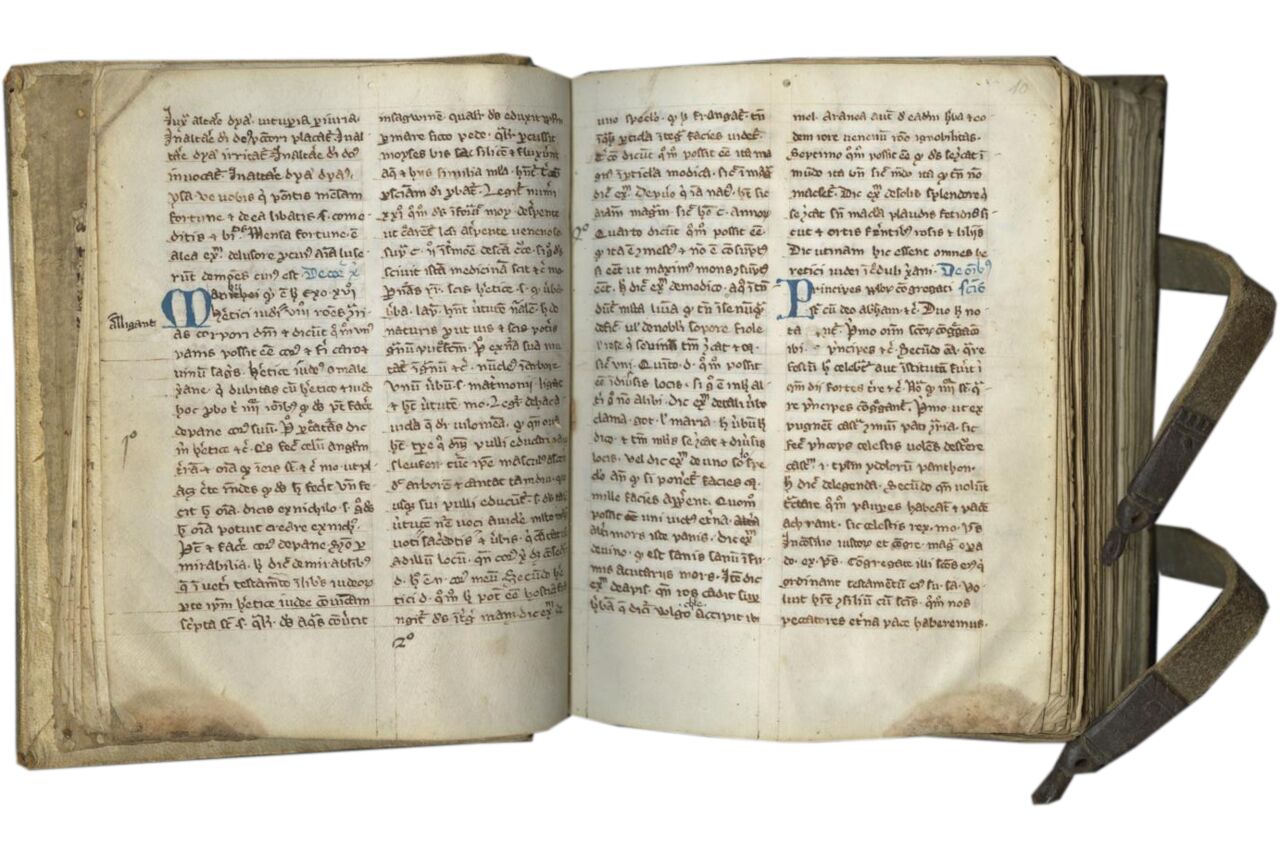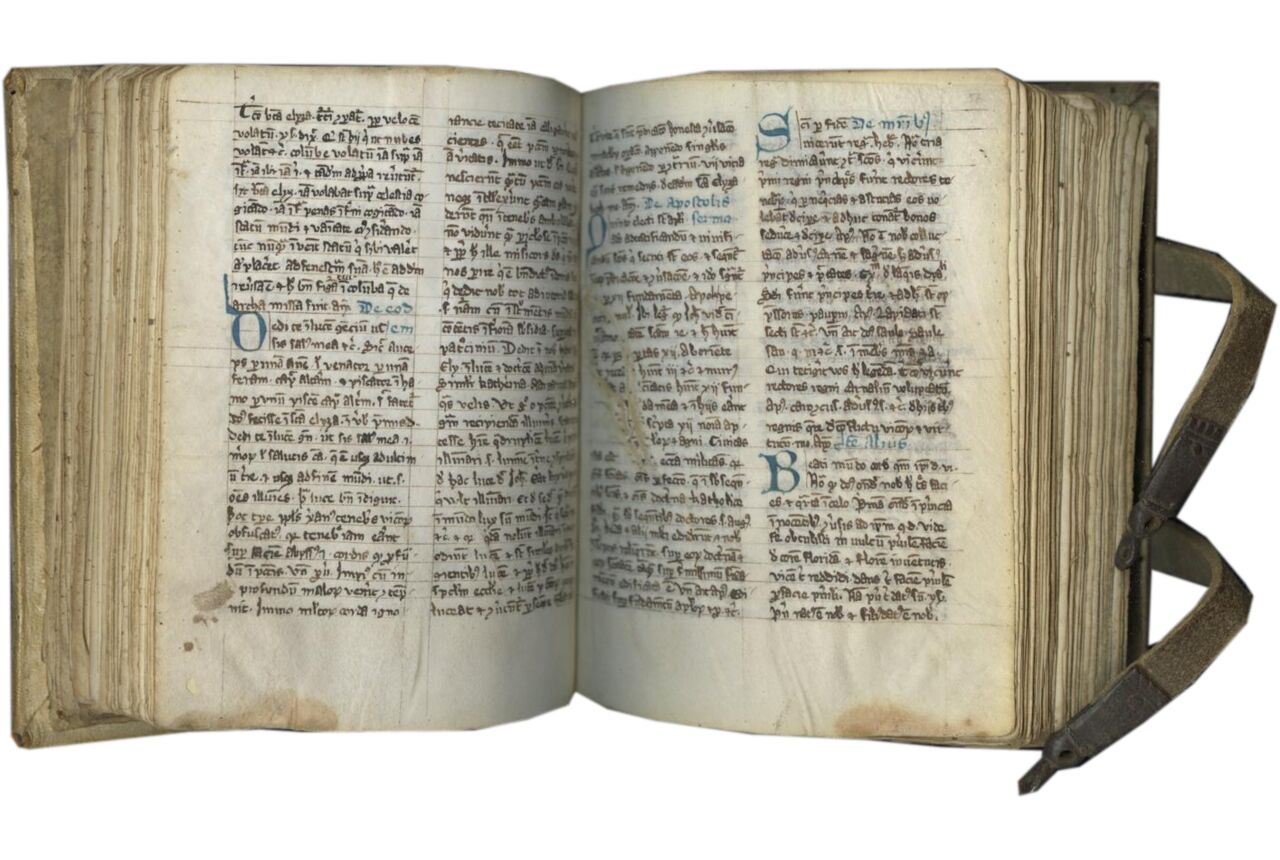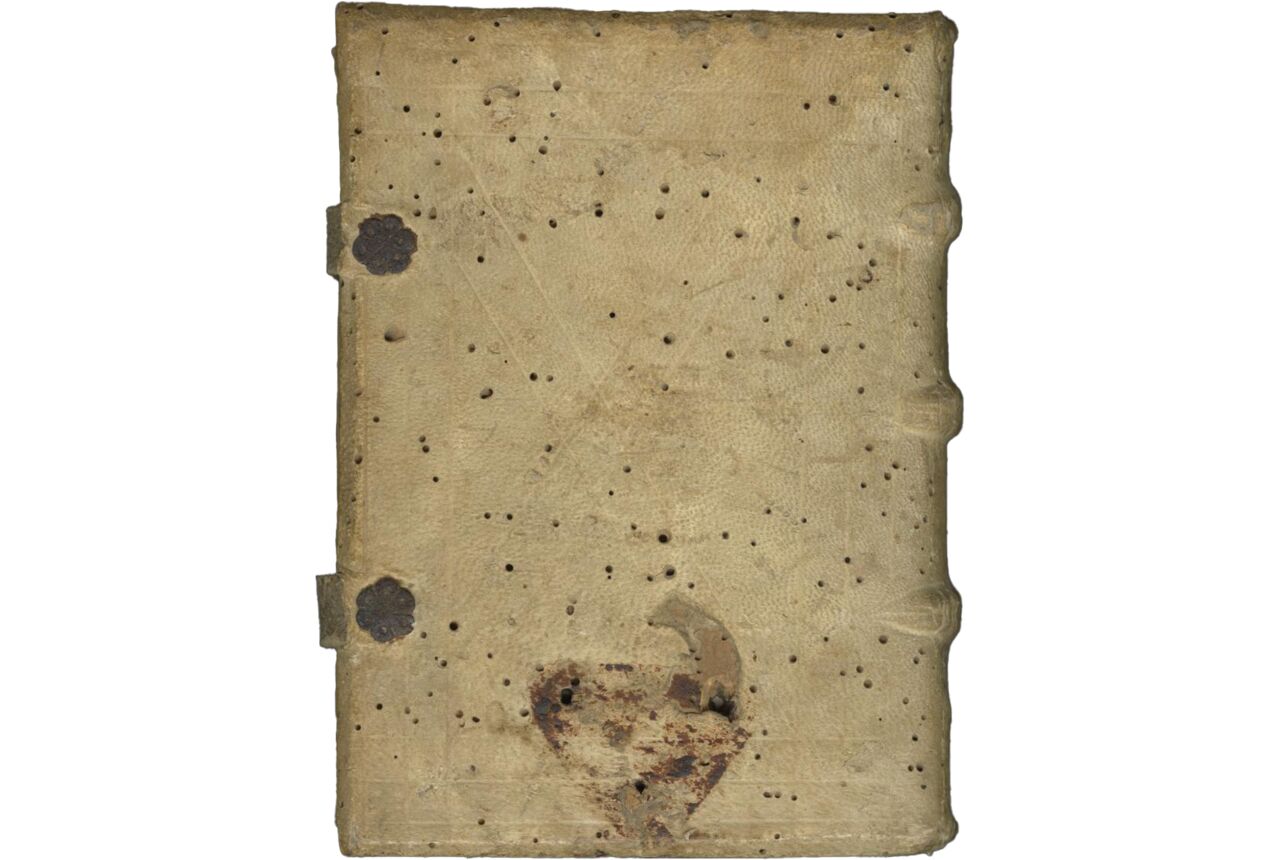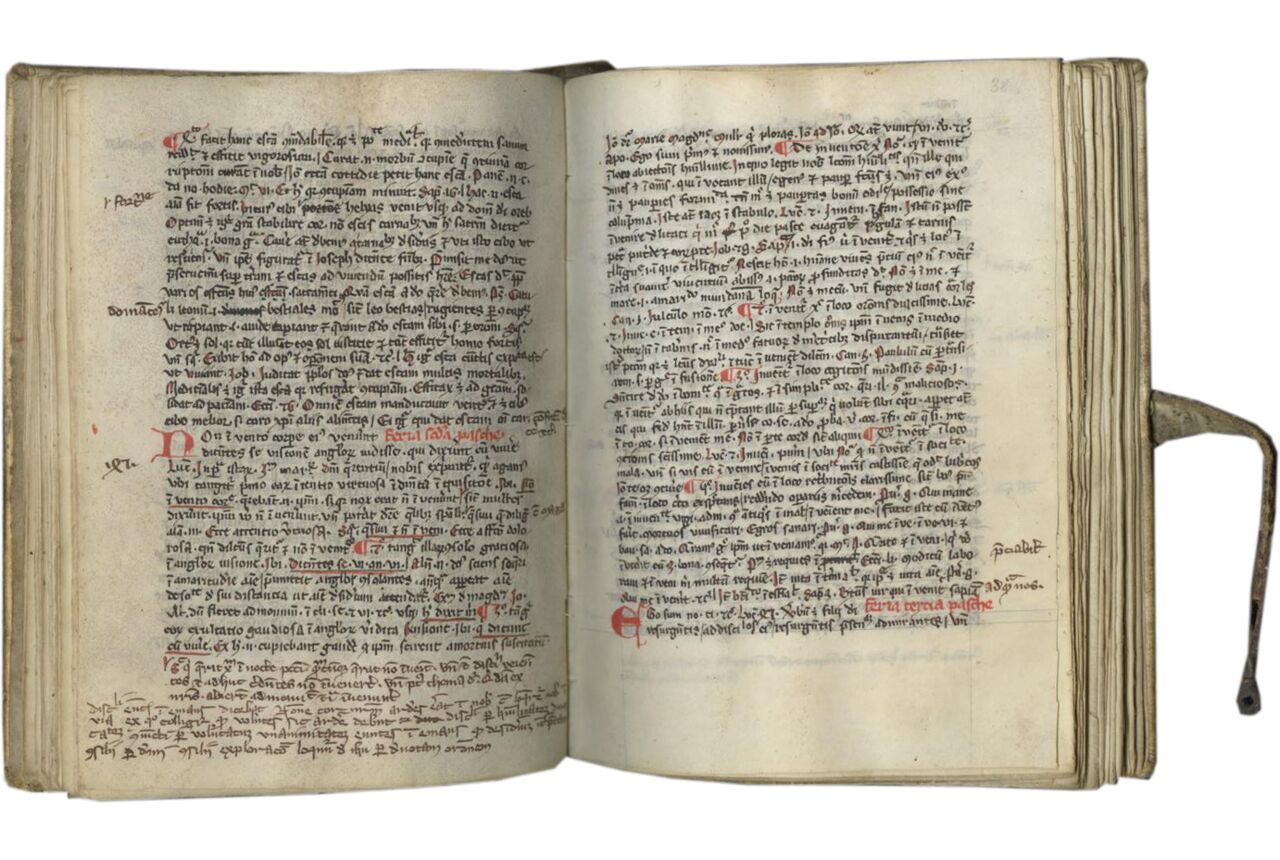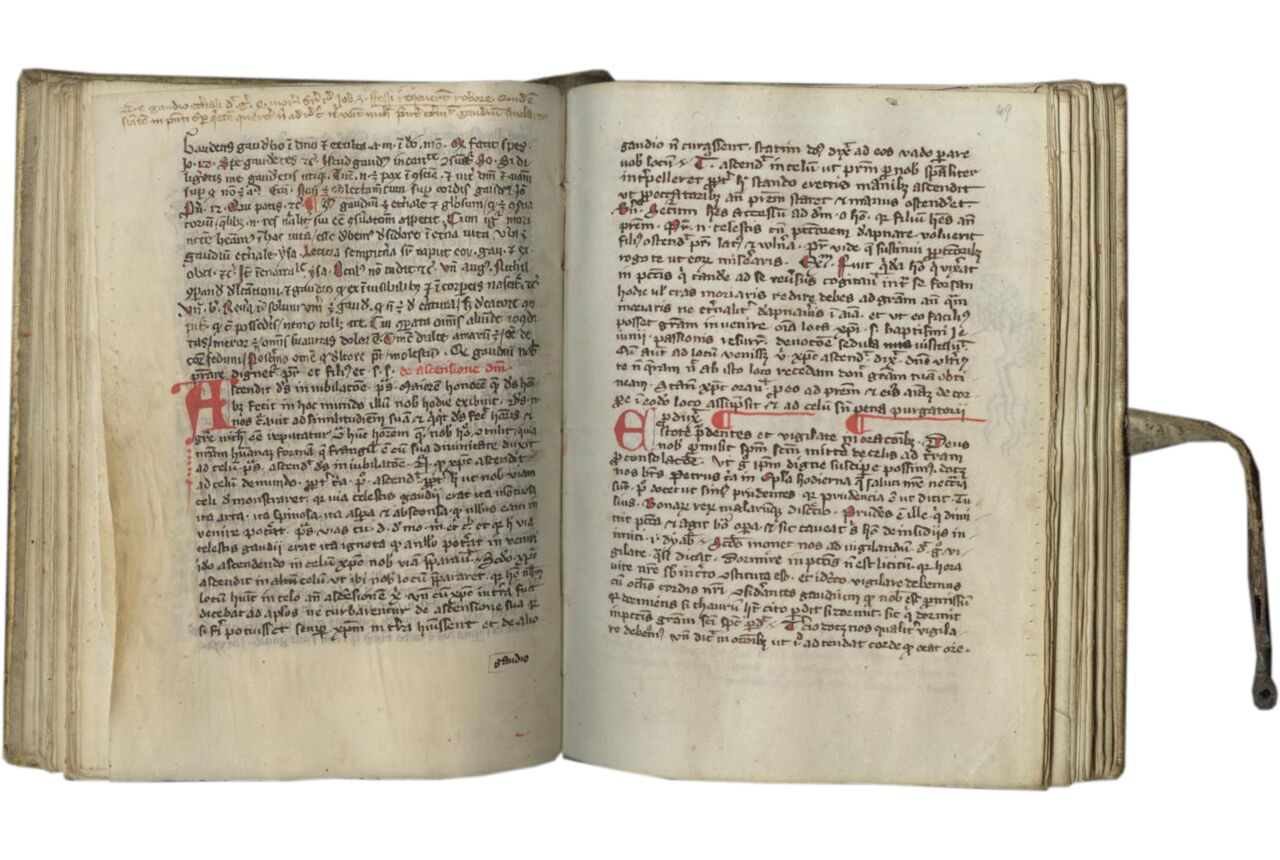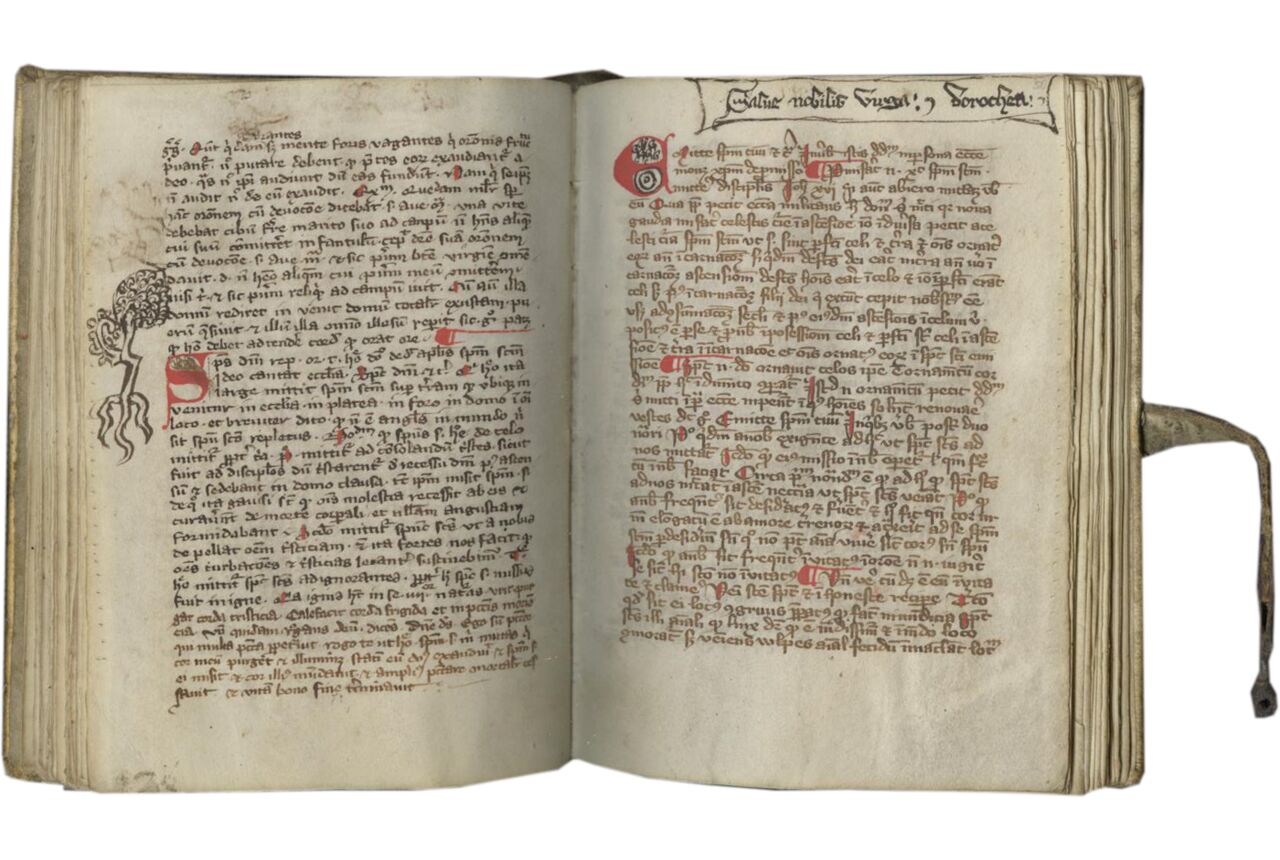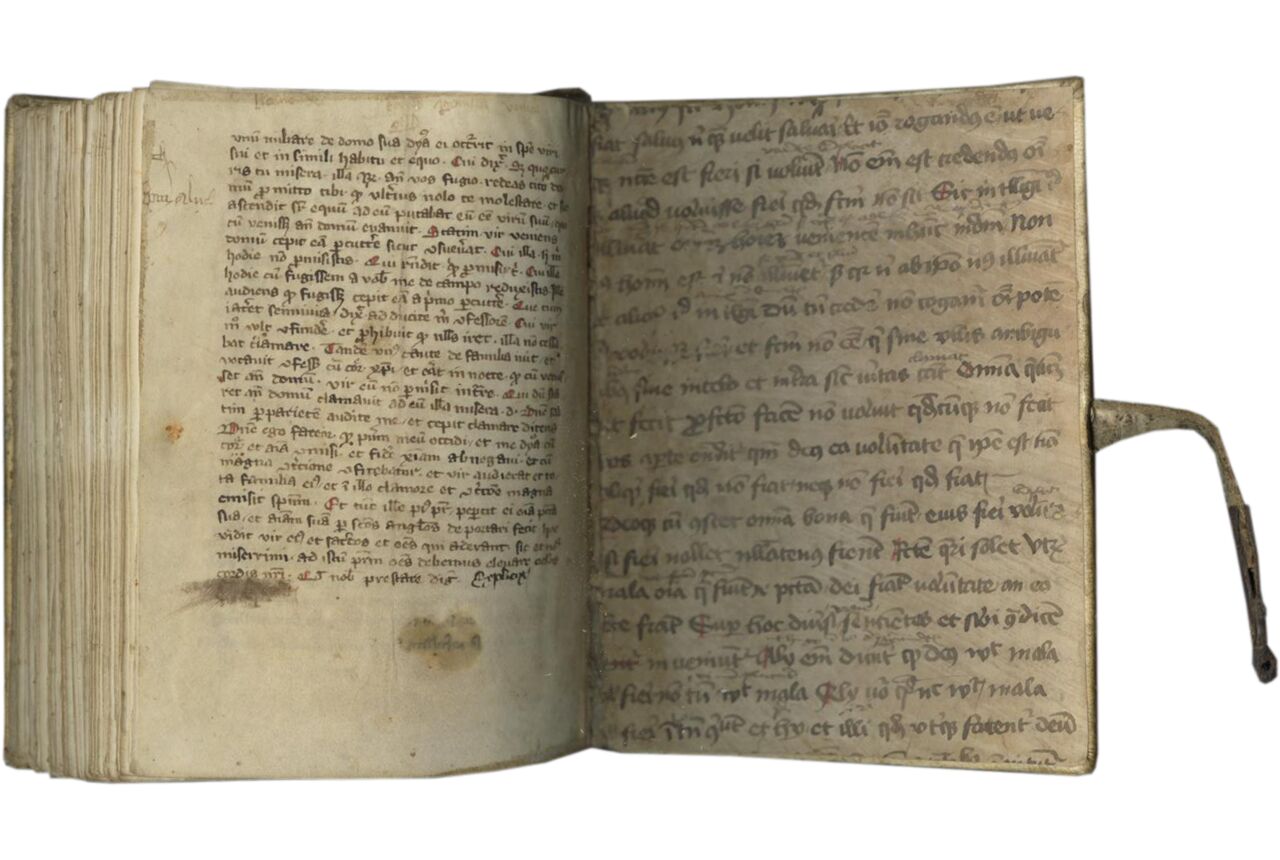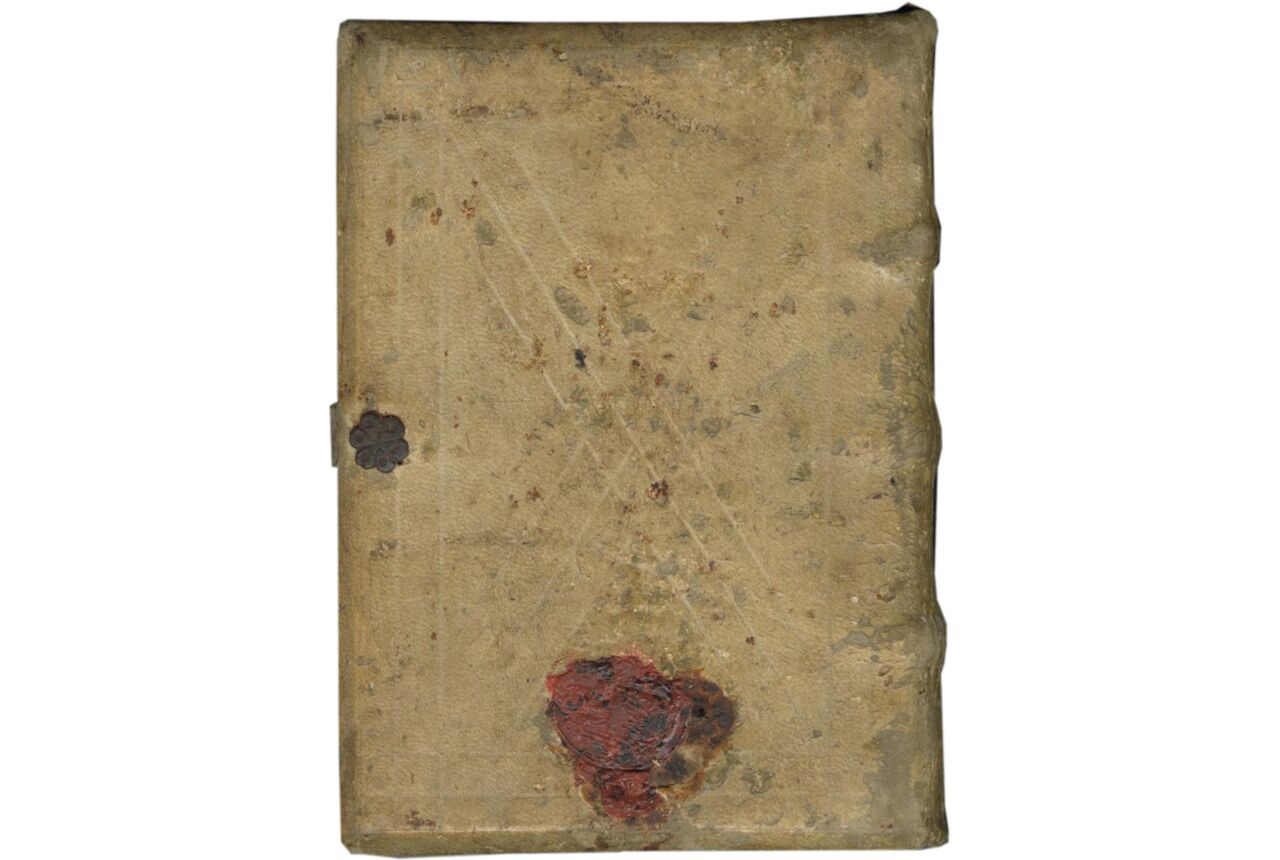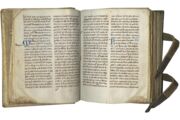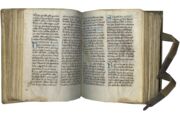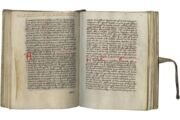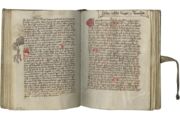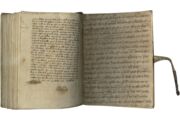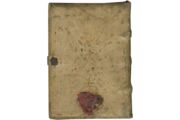Volume one: 96 folios on parchment, partial modern foliation in pencil, top outer corner recto, 1-96, complete (collation i-iv12 v-vii8 viii10 ix8 x6), horizontal catchwords throughout, layout varies: scribe 1: ff. 1-48v, ruled in lead with the top two and bottom two horizontal rules full across, single full-length vertical bounding lines, prickings outer margins (justification 122 x 88-85 mm.), written in 32 long lines in a quick gothic bookhand (note all the scribes begin below the top line), ff. 49- 88, ruled in brown ink(?) with top and bottom rules full across, single full-length vertical bounding lines, prickings outer margin (justification 127-123 x c.90 mm.), in an early cursive gothic script (cursive antiquior; on f. 49, the script is closer to a bookhand), with a 2-compartment ‘a’, long ‘f’ and ‘s’, looped ascenders, in 29-34 long lines, f. 88, last 7 lines-89v, line 5, new ink and perhaps a new scribe, with another scribe beginning f. 89v, line 6, ruled very lightly in pencil, (justification 128 x 90 mm.), in a cursive gothic book hand in 24-29 long lines, notes for rubricator occasionally remain in the margins, majuscules touched in red, quotations underlined in red through f. 47v, paragraph marks, rubrics (rubrics lacking ff. 49-end; blank spaces or empty paragraph marks remain), simple 2- to 3-line initials in red, a few with red pen decoration, first leaf damaged (damp or water) with the top quarter of the text mostly illegible, a few spots and stains throughout, overall in very good condition. FOURTEENTH- or FIFTEENTH-CENTURY BINDING of white sheepskin over wooden boards, sewn on three double thongs, boards tooled with simple double fillet in frame and forming a saltire cross in center, pastedowns are leaves from earlier medieval manuscripts (described below), back cover, lower edge, mark and rust from a hasp (now missing) from a chained binding, covered with wax with an armorial seal embossed over them with ‘IHS’ in center of shield, spine with three raised bands and title in ink at top (now largely rubbed away), fifteenth-century title-plate in vellum, top, upper board (“Sermones de tempore”), one working strap and pin fastener (fastening back to front), some scuffs to edges, but in very good condition. Dimensions 170 x 124 mm.
Volume two, 121 folios on parchment (with some original holes, and many off-cuts), modern foliation in pencil, top outer corner recto, complete (collation i-v8 vi10 vii-xiv8 xv8 [8, unnumbered pastedown]), quires numbered throughout at the beginning of the quire in roman numerals, no catchwords, ruled, usually lightly, in ink, sometimes with the top and bottom two rules full across, prickings often remain outer margins (justification 122-120 x 95-90 mm.), written in two columns of 27 lines by two or three scribes in an informal, quick gothic bookhand with tall double-looped ‘a’ and some looped ascenders (almost entirely by one hand), blue rubrics, blue 2- to 3-line initials, some discoloration and cockling to first few leaves, outermargins trimmed away ff. 30-32, marginal stains (mostly at the bottom margin, with a stain in the upper margin at the end of the manuscript), overall good condition. FOURTEENTH- or FIFTEENTH-CENTURY BINDING of white sheepskin over wooden boards, sewn on three double thongs, boards tooled with simple double fillet in frame and forming a saltire cross in center, front pastedown possibly reused from an earlier manuscript (text scraped), but with a small fragment from another manuscript glued on (described below), mark and rust from the hasp, now missing, of a chained binding, bottom edge, back cover, spine with three raised bands and title in ink, “sermones de tempore,” fifteenth-century title-plate in vellum pasted to head of front board, “Sermones de tempore et de sanctis et de aliis diversis materiis theologie <two further words, now faded>”, two working strap and pin fasteners, fastening back to front, boards are wormed and slightly bowed, some scuffs to edges, but in very good condition. Dimensions 160 x 124 mm.
Sermons remain one of the great untapped sources for understanding medieval life, thought, and religion. These two volumes include hundreds of sermons awaiting further study; none at the moment are identified as by known authors (very preliminary research has found only two relevant comparisons in the literature). The contents are tantalizing, including exempla (moralizing tales), and unusual topics, from Noah’s ark to Divine Love. Physically, these volumes hold a special interest. Small in size, copied by a number of scribes in informal but legible scripts, and still preserved in early (perhaps original) bindings, these are marvelous survivals from the monastic past.
Provenance
1. Based on the evidence of the script, these two manuscripts were copied in Upper Austria over a period of years; the first part of volume one was perhaps copied in the late thirteenth or early fourteenth century, and this volume was completed in the second quarter of the fourteenth century by several scribes in distinctive early cursive gothic scripts (Derolez, 2006, pp. 133-134); evidence of the script suggests the second volume was also copied in the second quarter of the fourteenth century, perhaps in the 1340s (cf. the Garsten manuscripts described by Hranitzky, Online Resources, for context; and Holter, 1956, p. 297). It seems most likely to us that these two volumes were copied at Garsten, for the use of the of the monks themselves.
One must consider these two manuscripts as companions to one another (in this description we designate them as volume one and two). Evidence suggests they were copied around the same time; they are very close in size and are bound in very similar (although not identical) early Garsten bindings. Moreover, they have, very fortunately, been preserved together since they left Garsten Abbey. However, it may be more accurate to consider them as complementary volumes, rather than as a two-volume set. Further research is needed before any firm conclusions about their origin and exact relationship with one another can be established.
2. These volumes (or possibly just volume two) may have been reserved for the use of Garsten’s abbots in the fifteenth and sixteenth centuries. A memorial note for Abbot Florian I von Tampeck (1399-1419) is copied on f. 119v in the top margin of volume 2, “Florianus domina miseracione/ Abbas in Gerstin Amen.” And “Johannes abbas,” is written in the inside front cover of volume two in a sixteenth-century hand, possibly an ex libris of Abbot Johan Spindler (abbot of Garsten 1574-1589; d. 1600). Spindler was a member of the imperial council from 1599, and an important figure of the counter-reformation, who expelled newly Protestant ‘monks’ openly living in Garsten with their families and returned it to strict Catholicism (Online resources). He added considerably to the buildings of the community, and had their oldest manuscript, a Gospel Book, opulently rebound.
The manuscripts are still preserved in fourteenth- or fifteenth-century bindings, possibly original, and almost certainly from Garsten, where they must have been part of the monastery’s chained library. Some of the other manuscripts bound at Garsten had hasps for a chain attached at the top (perhaps the hasps in our manuscripts were placed at the bottom edge because of their small size), but the bindings are similar to others from the Abbey. Two examples, based on a preliminary search: note the very similar binding on Linz, Oberösterreichische Landesbibliothek (früher: Studienbibliothek), HS 296 (Online Resources); and the identical rosette-shaped hardware on the back cover of Linz, Oberösterreichische Landesbibliothek (früher: Studienbibliothek), HS 379 (Online Resources).
3. A seventeenth-century inscription at the bottom of f. 1 of each volume identifies them as nos. 48 and 55 in the inventory of Garsten’s library: v. 1, “Catalogo librorum Monasterii Beate Virginis in Garsten [no.; crossed out] 48.”; v. 2, “Ex libris Monasterii Beate Virginis in Garsten [no.; crossed out] 55 [originally 50?]. Prior Seraphin Kirchmayr made an inventory of the library of Garsten in 1631 (now preserved in Linz, Oberösterreichisches Landesarchiv, HS 3/StiftsA-Garsten, and these annotations likely date from then).
Garsten Abbey was founded c. 1080 by Ottokar II, Margrave of Austria as a community of secular canons and the resting place of his family. In 1107 the monastery was made a priory of the Benedictine Abbey of Gottweig. It became an independent abbey three years later and flourished throughout the Middle Ages. Garsten Abbey was dissolved in 1727, and the buildings became a prison. A small part of the monastery’s library was sold to the Hofbibliothek in Vienna, but the remainder of the books and all of the archives were left in situ and unguarded until losses forced Church authorities to transfer them into storage in Graz in 1819 and then Gleink in 1850. In 1910 the Church presented the remaining medieval codices and 573 charters and documents to the Oberösterreichisches Landesarchiv in Linz. The present volumes may have left with one of the last inmates in 1727, or at some later date before 1910.
4. Belonged to A. W. Sommer, Steyr, Upper Austria.
5. Belonged to Dr. Gerhard Eis (1908-1982), Germany, Reichenberg, German medievalist and historian of medicine (Online Resources). Eis was also a noted collector, who assembled a sizable library; these are his MSS 39 and 40, and include his bookplates: inside front cover, volume one; inside back cover, volume two. In volume 2 the bookplate includes a note in pencil recording the purchase of that volume (and presumably both) in May 1939.
Text
Volume one: front pastedown: Leaf from a twelfth-century copy of Boethius, Consolation of Philosophy, oriented vertically to the volume, with small margins remaining at top, left, and right, but cut-off in the middle of the leaf (now in the gutter); text partially obscured by Eis’ book label (left column of leaf), and partially illegible in the upper right column. Incipit, “//Respicite celi spatium firmi//[tudinem] … An tu arbitraris//” (book 3, Wilhelm Weinberger, ed., CSEL 67, 1934, p. 59, line 1-p. 60, line 23). Ruling is now indiscernible (originally lead?), written in a good minuscule from the second half of the twelfth century in two columns, 20 lines. This may be the remnant of a twelfth-century manuscript from Garsten itself;
Volume one: back pastedown: Leaf from a fourteenth-century theology manuscript, with 18 widely spaced lines, one column in a Gothic cursive, oriented as the main text, top line and inner margin trimmed; last line is complete, but leaf may have been larger; the small outer margin is intact, incipit, “//fiat salvus nisi quem uelit salvari. Et ideo rogandus est … et illi quidem vtique factentur deum//”;
Volume 1, ff. 1-96v, Sermo de aduentu domini, incipit, “Orietur in tenebris lux tua etc. Ysa. 58[:10]. Viri <illegible> deo patri et natiuitatem dominicam subtiliter in lucis …; … [ff. 95v-96v], incipit, “Cum subleuasset oculos jesus. Io. vi:[5]. Multis locis legitur de sub levatione oculorum christi. Hoc autem Christus fecit …. Omnes debemus eleuare oculos nostri. Quod nobis prestare dignus,” [added:], Explicit.
The cycle for the Temporal in volume one begins with the first Sunday in Advent and the Sundays following (ff. 1, 2, 3, 4v, 5v), continuing with Christmas (f. 6v), St. Stephen (f. 7v), the Holy Innocents (f. 9r), St. Thomas (f. 10), f. 12v, Sunday in the Octave of Nativity, Circumcision (f. 13v), Epiphany (f. 14 and 15v), Sunday in the Octave of Epiphany (f. 16v), Sundays following Epiphany (f. 17v, 18v, 20), Septuagesima (f. 22) and then including (among others), the Sundays following Septuagesima, Quadragesima (f. 27v) and the Sundays following, Passion Sunday, (f. 33v), Easter (f. 37v), Ascension (f. 48v), followed by sermons without rubrics, but continuing the cycle of the Temporal; the biblical theme of the final sermon from John 6:5 is found in other sermon cycles for the twenty-fourth or twenty-fifth Sunday after Pentecost, and this is possibly the feast concluding the cycle in our manuscript as well.
Volume 2, front pastedown, early leaf, now erased, used as a pastedown (previously identified as from a Choirbook, c.1100, but we have been unable to read any of the text, although it may be recoverable with imaging), with a small fragment from a fifteenth-century manuscript glued on, 87 x 23 mm., 14 partial lines, with a text in German, perhaps Margaretenlegende (Handschriftencensus, Online Resources);
Volume 2, ff. 1-119v, incipit, De benedictione, incipit, “Petito et accipietis. Primo cum abbatum constanter et frequenter. Gen. xviii[:20]. Clamor sodorum …”; … [f. 119rv], Item nota, incipit, “Daniel xiiii[:2]. Apud babilones erat ydolum nomine bel quod adorabat rex … cum uxoribus et filiis et familia, Amen”; [ending f. 119v, mid col. a; col. b, later memorial note, see Provenace above, and “Domine exaudi orationem mean”; f. 120, a few later pentrials; ff. 120v-121v, blank, but ruled].
Volume two contains texts for preaching as well as sermons, complete with their biblical theme, many with rubrics suggesting a topic, and others, the liturgical occasion, including some sermons from the Temporal and Sanctoral, beginning with a “De benedictione” (On blessing or benediction), and including (among others), f. 3v, On sin, f. 5v, On contrition, f. 5v, On the Mass, f. 6v, On the falseness of the world, f. 7v, On dedication (of a church?), f. 8, Apostles, f. 9v, On the Body of Christ, ff. 10, 11, and 11v, All Saints, f. 14, All Saints and All Souls, f. 15 and 16, All Souls, f. 16, On the ten signs, f. 17, Advent, f. 17v, Advent and Annunciation, f. 20, 20v, and 21, Christmas, [continuing with feasts from the Temporal, Stephen, John, Epiphany], f. 25v, 27, and 27, Annunciation of Mary, ff. 28v and 29v, Passion Sunday, f. 31v, Palm Sunday, f. 33 and 34v, Easter, f. 36v, Ascension, f. 37v, Holy Spirit, f. 38, John, [followed by feasts from the Sanctoral, including Peter and Paul, Margaret, Corpus Christi], f. 42v, Blood of Christ, f. 43v, Rogation Days, f. 44, Mary Magdalene, ff. 46-50, numerous sermons for the Assumption, [continuing with the Sanctoral and concluding with Elizabeth, followed by sermons for the Common of Saints, sermons in honor of the Virgin, and sermons for the Dedication of a Church, followed by sermons, some without rubrics, for the Sundays following Pentecost from the Temporal concluding with Sunday twenty-five on f. 81, [followed by a rich collection of sermons on different themes and moral topics including f. 83, Day of Judgement, f. 83v, [divine] love, f. 85, Noah’s ark, f. 92, An exemplum (moralizing story), f. 93v, thieves, f. 98v, the temptations of the devil, and f. 104v, Purgatory].
This is an extraordinarily rich collection of approximately 220 texts: in volume one, seventy sermons with rubrics for feasts of the Temporal through f. 49v, and approximately one hundred and fifty sermons and material for sermons in volume two. Only a small sample of these sermons (in volume one, nineteen on ff. 1-23v, and the final sermon; and in volume two, fourteen sermons, through f. 17v; see the summary of texts appended at the end of this description) were checked in Schneyer, resulting in only two possible identifications (judging from similarities with the incipits listed in Schneyer), one anonymous sermon from a fourteenth-century manuscript now in Rome, Biblioteca Casanatense, MS 338 (Schneyer, 1969-1990, vol. 9, p. 466, and the other a sermon listed in Schneyer, vol. 2, p. 46 (this volume was not available for consultation).
In volume one, a later hand noted the presence of exempla on ff. 88v, 90, 92, 94v, 96, and one suspects the sermons throughout this volume are peppered with these moralizing stories that shed so much light on daily life in the Middle Ages; a rubric in volume 2 signals the presence of an exemplum on f. 92. The contents of the second volume are particularly rich. Although there are groups of sermons for the type of liturgical occasions typical for medieval sermon manuscript for the feasts of the Temporal (movable feasts centering around Easter), the Sanctoral (feasts of saints and other occasions that occur on the same day every year), and the Common of Saints, their order is variable, and the sermons on various topics, from divine love to Noah’s ark and for different audiences (not only sermons “ad religiosos” but also for thieves) are unusual and promise to reward further research. On f. 82, a wonderful rubric advices, “On the face of divine brightness, choose a theme of all gladness or joy (De facie divine claritatis pone thema de omni gaudio aut leticia). Volume one includes occasional corrections and comments in later hands, usually brief; and at least two pious invocations in more formal gothic scripts, top margin, f. 1, to the Virgin, and f. 50, to St. Dorothy. On f. 49v, someone has drawn a tree. The margins of the second volume, in contrast, are empty; could this volume record sermons and other texts made by a monk at Garsten for his own use, possibly reflecting sermons preached at the Abbey?
There are over 120 surviving manuscripts from the monastery at Garsten, most of them at the Linz, Oberösterreichische Landesbibliothek (Holter, 1956; and 1985, pp. 91-119, and 370-383, cat. 4.08-4.043; and Online Resources). These two manuscripts are an important addition to this corpus, not only for their primary texts, but also for the fragments preserved in their bindings, in particular the leaf from a twelfth-century manuscript of The Consolation of Philosophy by Boethius, evidence of manuscripts from the monastery’s library that would otherwise be lost.
Appendix (Text of selected sermons)
Volume one: f. 2, Dominica i, incipit, “Leuate capita vestra quoniam appropinquate redemption vestra. Luc [21:28].Verbum est diuine consolationis …”; f. 3, Dominica secunda, incipit, “Letamini gentes cum plebe eius. Ro. 15[:10]. In hoc verbo apostolus nunc misticus aduentus dominici exhortans …”; f. 4v, Dominica iii, incipit,“Dominus prope est etc. Moris est divinorum prenuntiare aduentus …; f. 5v, Dominica quartus, incipit, “Nolite ante tempus iudicare quoadusque veniat dominus… etc. [1 Cor 4:5]. Moraliter magister. Apostolus in hoc verbo in tribus compendiose …”; f. 6v, De Nativitate domini, incipit, “Cantate domini canticum novum … etc. Ps. [95:1]. Moris est regum…; f. 7v, De sancto Stephano, incipit, “Quis est hic et laudabimus eum … Ecccus 31[:9]. Quando ignotus nules vincit …”; f. 9, De innocentibus, incipit, “Ex ore infantium deus et lactentium perfecisti laudem etc. [Mt 21:16]. In hoc uerbo tangitur tota sollempnitas hodierna …”; f. 10, De sancto thoma, incipit, “Bonus pastor animam suam dat pro ovibus suis. Io. 10[:11]. In hoc verbo beatus Thomas gloriosus martir et pontifex …”; f. 12v, Dominica infra oct nativitate, Quoniam filii dei estis misit deus spiritum filii sui in corda vestra. [Gal. 4:6]. Oraverunt pro ipsis ut acciperent spiritum sanctum [Acts 8:15]. Reddeunt petitiones acceptandas pententiu m …” [cf. Schneyer, Repertorium, v. 2, p. 46 [not verified, volume not available]; f. 13v, In circumcisione, incipit, “Vocatum est nomen eius Iesus. Luc 2[:21]. In hoc verbo duo breviter innuit sanctus Lucas …”[cf. Schneyer, Repertorium, v. 9, p. 466];
f. 14, In epiphania domini, incipit, “Surge illuminare Jerusalem …, Ysa [60:1]. In quo propheta ewang[elia] iam christo per natiuitatem cognito ad gaudium …”; f. 15v, In epiphania, incipit, “Ubi est qui natus est rex iudeorum. [Mt. 2:2]. In hoc verbo tangitur illorum regum …”; f. 16v, Dominica infra octava ephiphanie, incipit, “Cum factus esset ihesus … Luc. 2[:42]. Ascensus[?] iste devotissime virginis exemplum ascendenditur nobis tribuit …”; f. 17v, Dominica prima post Epiphania, incipit, “Spiritu ferventes domino seruentes [Ro. 12:11] Jo. In hoc verbo ad duo nos incitat …”; f. 18v, Dominica tertia post ephiphania, incipit, “Ego veniam et curabo eum. Mt 8:[7]. Nota et expone textum ewangelis. Per leprosum genus[?] humanum …”; [sic, there is no sermon for the second Sunday after Epiphany]; f. 20, Dominica Quarta post ephiphania, incipit, “Diliges proximum tuum sicut te ipsum [Mt. 19:19]. In hoc verbo apostolus primo premittit personis consumationi …”; f. 22, Dominica in Septuagesima, incipit, “Illi quidem ut corruptibilem coronam accipient nos autem incorruptam. 1 Cor. 9:[25]. In hoc verbo apostolus arguit …”;
f. 23v, Dominica prima Septuagesmia, incipit, Virtus in infirmitate perficitur Cor. 11 [2 Cor. 12:9]. Verbum est apostolus. Nos ad passionum tollandam …”;
Volume two, selected sermons and other texts: f. 3v, Omne[?] thema valet adque peccatum poterit applicari, incipit, “Peccatum fecit v. mala in homine. Primo <co?>in quidem animam. Secundo contriscat sum et turbat eam. Tercio infirmat sum infirmam facit …”; f. 5v, De contritione, incipit, “De contritione viii[?] inuitas sanctorum …”; …; f. 7v, In dedicatione, incipit, “Terribilis est locus iste. Gn xxviii. Ait iacob <?>. Nota quod est multiplex locus …”; f. 8, De apostolis, incipit, “In domo patris … Jo. xiiii. Ascendit inter pandens ante eos. Mich ii. …”; f. 8v, Notabile, incipit, “Altaria tua domine … ps. Multiplex altare invenitur, scilicet ara celi, ara nostre redemptionis …”; f. 11, De eodem, incipit, “Rex aswerus fecit grande convivium omnibus principibus suis …”; …; f. 14, De omnibus sanctis sum animabus, incipit, “Bibite et comedite amici et inebrari Karissimi. Dominus ihesus in celebracione sui conuiuii. De quo ma[erius]. Homo quidam fecit cenam magnam …”; f. 15, De omnibus animabus sermo, incipit, “Beati mortui qui in domino moriuntur. Fratres karisimi heri celebramus die ominium sanctorum. Hodie celebramus memoriam omnium fidelium defunctorum. De quibus beati mortum etc. Sed modo nota quod quidam moriuntur in domino. Alii in mundo. Alis in dya[bolus] …”; …; f. 17, Sermo de aduentu domini, incipit, “Emmite manum de alto libera me de aquis multis. Psalmus. Qui in aqua …”; f. 17v, De adventu et annuntiacione commune, incipit, “Dabit dominus ipse uobis signum reconciliacionis peccatoris cum domino. Ysa. Libera communis a diabolo? signum sanctitatis …”
Literature
Ardelt, Rudolf. “Beitrag zur Geschichte des Stiftsarchivs Garsten,” Jahrbuch des Oberösterreichischen Musealvereines, 125/I (1980), pp. 109-118.
https://www.zobodat.at/pdf/JOM_125a_0109-0118.pdf
Derolez, Albert. The Palaeography of Gothic Manuscript Books: From the Twelfth to the Early Sixteenth Century, Cambridge, U.K. and New York, 2006.
Frieß, Gottfried Edmund. “Geschichte des Benedictiner-Stiftes Garsten in Ober-Oesterreich,”
Studien und Mitteilungen aus dem Benediktiner- und Zisterzienserorden 1,3 (1880), pp. 28-49.
Holter, Kurt. “Zum gotischen Bucheinband in Österreich: Bemalte Einbände aus Kloster Garsten,” Gutenberg-Jahrbuch (1956), pp. 288-298.
Holter, Kurt. “Das mittelalterliche Buchwesen im Stift Garsten,” in Litschel, et al., 1985, pp. 91-119, and 371-385.
Litschel, Helga, et al. Kirche in Oberösterreich: 200 Jahre Bistum Linz : Oberösterreichische Landesausstellung 1985, 26. April bis 27. Oktober 1985, im ehemaligen Benedektinerstift Garsten, Linz, 1985.
Mittelalterliche Bibliothekskataloge Österreichs, v. 5, Oberösterreich, ed. Herbert Paulhart, Vienna, 1915, (Garsten, pp. 19-24).
Franz Xaver Pritz, Geschichte der ehemaligen Benediktinerklöster Garsten und Gleink im Lande ob der Enns und der dazugehörigen Pfarren, Linz, 1841.
Geschichte der ehemaligen Benediktiner-Klöster Garsten und Gleink, im Lande ... - Franz Xaver Pritz - Google Books
Schneyer, Johannes Baptist. Repertorium der lateinischen Sermones des Mittelalters: für die Zeit von 1150-1350, Beiträge zur Geschichte der Philosophie und Theologie des Mittelalters 43, Münster, 1969-1990.
Online Resources
Linz, Oberösterreichische Landesbibliothek (früher: Studienbibliothek), Hs.-296 (Schiffmann 62)
https://digi.landesbibliothek.at/viewer/image/296/5/
Linz, Oberösterreichische Landesbibliothek (früher: Studienbibliothek), Hs.-379 (Schiffmann 117)
https://digi.landesbibliothek.at/viewer/image/379/236/
Mittelalterliche Handschriften in Österreich (manuscripta.at) (Bibliography related to Garsten Abbey manuscripts, with links to surviving manuscripts)
Bibliographie manuscripta.at
Katharina Hranitzky, “Katalog der illuminierten Handschriften der OÖ Landesbibliothek: ca. 1220-1400” (Rahmen des vom Forschungsfonds FWF finanzierten Forschungsprojektes), Cod. 458 and Cod. 461.
https://digi.landesbibliothek.at/viewer/overview/461/1/
https://digi.landesbibliothek.at/viewer/overview/458/1/
Abbots of Garsten (Biographia Benedictina)
http://www.benediktinerlexikon.de/wiki/Garsten/%C3%84bte
“Johann Spindler,” Biographia Benedictina
Spindler, Johann – Biographia Benedictina
Handschriftencensus, Online-Datenbank zu sämtlichen deutschsprachigen Handschriften des Mittelalters (750-1520), Eis, HS 40 (our manuscript)
https://www.handschriftencensus.de/14546#cLiteratur
Gerhard Eis (Wikipedia) https://de.wikipedia.org/wiki/Gerhard_Eis
TM 1354



